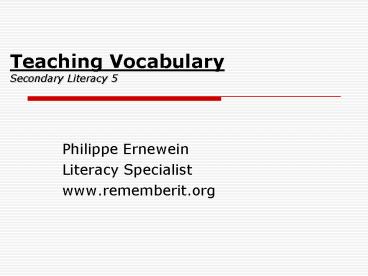Teaching Vocabulary Secondary Literacy 5 - PowerPoint PPT Presentation
1 / 34
Title:
Teaching Vocabulary Secondary Literacy 5
Description:
HS social studies text. Our job: Not just identify rare words that students do not now ... Analyze vocabulary lesson plans for content. Consider the following: ... – PowerPoint PPT presentation
Number of Views:69
Avg rating:3.0/5.0
Title: Teaching Vocabulary Secondary Literacy 5
1
Teaching VocabularySecondary Literacy 5
- Philippe Ernewein
- Literacy Specialist
- www.rememberit.org
2
Journal
- In 1995, Hart Risley studied vocabulary
development of high SEC and low SES children over
time. They did intense observations of children
of professors at the University of Kansas and
children of the Turner House, a pre-school
located in the impoverished Juniper Gardens area
of Kansas City.
3
Journal
- The following graph shows the general trend they
found. - What are the implications of it for you?
- What responses does it raise for you?
- Turn to your journals now.
4
(No Transcript)
5
(No Transcript)
6
Betty Hart and Todd R. RisleyCorps Members in
Spirit
- 1960s War on Poverty
- Optimistic effort to intervene early to
forestalleffects that poverty was having on some
childrens academic growth. - Unique aspect of their approach
- 30 million word gap by age 3
- Achievement gap is a word gap
7
Final Thoughts on Hart Risley
- Estimating the hours of intervention needed to
equalize childrens early experience makes clear
the enormity of the effort that would be required
to change childrens lives - (Hart Risley, The Early Catastrophe).
- TFA as intervention which does not end, therefore
not an intervention, but the norm, the common
experience.
8
What Did You Write?
9
What are we learning?
- Three principles of effective vocabulary
instruction - Choose appropriate words to teach
- Outline a lesson plan using these three
principles
10
Why are we learning this?
- Effective vocabulary instruction is essential
- Given the word gap and high vocabulary demands of
secondary text, this instruction is critical
11
Reading Comprehension is an Interactive Process
Todays Session
RAND Model, 2002
12
Agenda
- DO NOW
- Introduction
- New Material
- Modeling
- Workshop
- Close/Journals
13
(No Transcript)
14
(No Transcript)
15
How to choose words to teach?
- Brick Words
- Key content words
- Observations, data, hypothesis
16
How to choose words to teach?
- Mortar Words
- Connecting words multi-use academic verbs
- However, Analyze, Compare
17
How to choose words to teach?
- Capstone Words
- Big academic concepts built upon brick words
- Experiment, Scientific Method
18
How to choose words to teach?
- Window dressing words
- Rare exotic words with low-utility
- Supercilious, banal, cravat
19
The Bottom Line
- Students will encounter unfamiliar words
- Focus key words
- Bricks, mortar and then capstone words
- Build meaning, avoid window dressing word
- Check for vocabulary understanding constantly and
informally
20
The 1920s A Time of Transformation
- HS social studies text
- Our job
- Not just identify rare words that students do not
now - But prioritize which words are most important to
teach students to meet objectives empower them
to read academic texts - Words they cannot do without
21
How do I teach them?
- Use Frayer Model to learn about concept of
effective vocabulary instruction
22
Frayer Model Effective Vocabulary Instruction
- Definition
- Well-planned and purposeful instruction that
provides students with deep understanding of key
words
23
Frayer Model Effective Vocabulary Instruction
- Key Characteristics
- Teaching a small number of words providing
student-friendly definitions. - Creating meaningful interactions with words that
lead to deep processing. - Providing multiple exposures in a variety of
contexts
24
Frayer Model Effective Vocabulary Instruction
- Example
- -On Monday, teacher gives definitions for five
bricks mortar words from a chapter, models,
gives example sentences, then involves students
in Think-Pair-Share using meaningful sentences. - -On Tuesday, students read the text, clarifying
meanings as they go. - -On Wednesday, students use these words in a
writing activity to respond to the text.
25
Frayer Model Effective Vocabulary Instruction
- Non-Example
- On Tuesday, teacher interrupts reading to have
students copy 15 words and their definitions from
glossary. - After that, they complete a worksheet filing in
the blanks for 15 unrelated sentences. - On Friday, they take a spelling test on the words.
26
Frayer Model multiple uses
27
Readers Theater
28
Content Area Groups
- Analyze vocabulary lesson plans for content
- Consider the following
- How does teaching the selected words help further
the content objectives? - How does the lesson engage students meaningfully
with the words and thinking critically about
vocabulary? What could you do to improve it in
this regard? - What would be needed to reinforce the learning of
these words?
29
The Big Three
- Focus on small number of words that were
essential to content objectives - Opportunity for students to actively work with
the words meanings by providing examples,
testing partners, creating visuals - Context for the words, sometimes just discussing
the word, then reading it, or many contexts as in
the math example
30
Workshop
- Hand-out Vocabulary Lesson Outline
- Using a text you are going to teach
- Select 5 key academic words of different types
- Bricks, mortar capstone
- Essential to understanding text
- Serve the purpose for reading the text
- Complete outline
- Hand-out Playing with Vocabulary, model lessons,
Secondary Literacy (31)
31
What did we learn?
32
Key Characteristics
- Teaching a small number of words providing
student-friendly definitions. - Creating meaningful interactions with words that
lead to deep processing. - Providing multiple exposures in a variety of
contexts.
33
Our bigger purpose
- To close the achievement gap, we must address the
vocabulary gap.
34
Check-out
- Homework?
- www.rememberit.org
- Journals to mailbox
- Names returned































